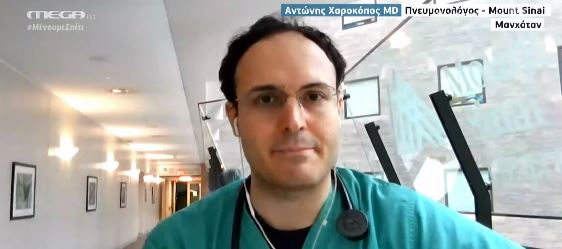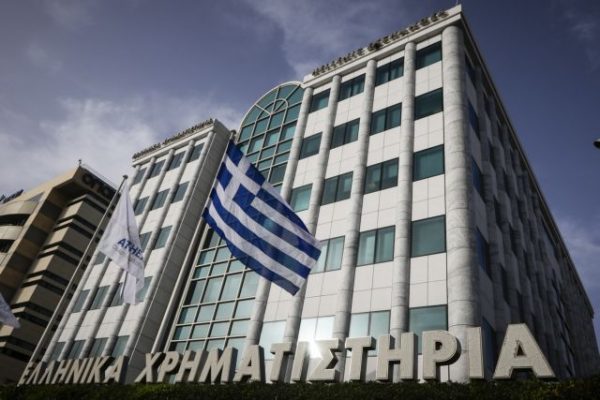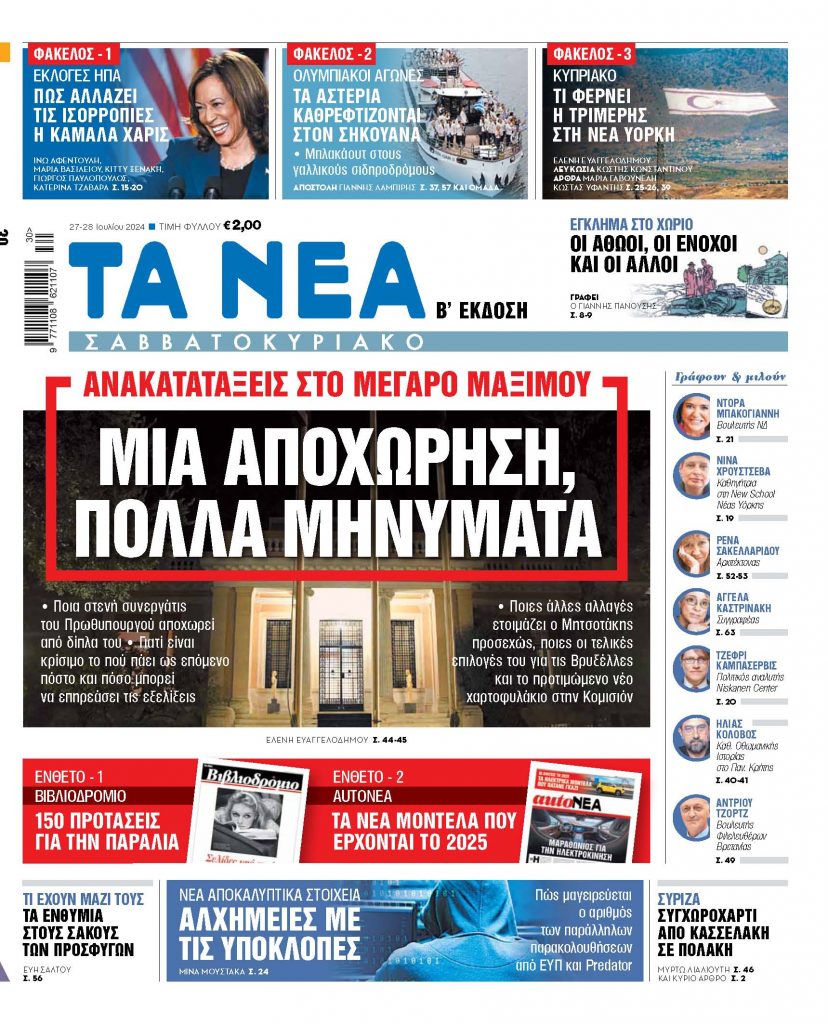The coronavirus pandemic for many Greeks was a belated introduction to the constellation of highly distinguished doctors, scientists, and researchers both in Greece and in ecumenical Hellenism from the US to Switzerland.
Antonis Charokopos, a Yale man and a top clinician at one of the world’s greatest hospitals, Mount Sinai Manhattan, has for weeks worked furiously on the frontline of treatment as a pulmonologist and ICU specialist.
In an exclusive interview with To Vima English Charokopos lays out the heart-wrenching moments of watching a patient die with no relative allowed at their bedside and the burden of being in America’s epidemiological ground zero – the hardest hit place in the country where the hair-raising sight of gathered freezer trucks is emblematic.
But it is standing by the dying that drew him to intensive care medicine and he underlines that his Faith is what has kept him and strengthened him to endure the crushing psychological burden of an unrelenting battle with the grim reaper.
In that context he cites the shocking suicide of New York ER specialist Lorna Breen.
He stresses the gnawing sense of helplessness from being unable to change the situation.
Charokopos also outlines the purely medical challenges and the scientific knowledge and treatment methods gleaned from the crisis.
Interestingly, he says he is not immune to nostos and that he would consider returning to Greece under the right circumstances.
Tell us a bit about you path from Greece to the US, Yale, and now Mount Sinai. What drew you to pulmonary medicine and then intensive care medicine on top?
I completed my middle and high school years in Thessaloniki. My high school, Mandoulides, had an American university application program, and I decided to give it a try as I had heard of the high quality of American colleges. I thankfully was accepted with a scholarship at Yale University where I completed a Bachelors and Masters in Biology, pursued my medical school at the Cleveland Clinic Lerner College of Medicine of Case Western Reserve (MD 2014), and then completed my residency in Internal Medicine at Yale-New Haven hospital, followed by my Pulmonary and Critical Care training at Mount Sinai in NY. I was particularly drawn to Pulmonary and Intensive care for a variety of reasons.
That included my interest in medical physiology (and the ICU is a place where physiology is very clearly visible due to the extremes of disease processes that are seen) and my interest in being by the bedside of patients and their families at what I consider one of their most sacred times of their lives, namely their death.
New York City was “Ground Zero” in the US epidemic, the eye of the storm with grim images of freezer trucks on call to bury thousands of citizens in mass graves. How did all that affect you psychologically? Might we see post-trauma syndrome among doctors and healthcare workers?
Undoubtedly NYC was the ground-zero of the epidemic in the US. The freezer trucks at the side of the hospitals and the rapidity at which patients would deteriorate and die was quite shocking, both for me and my colleagues. If I had to sum it up in one word, I would say “helplessness” in our strength, as medical providers, to change the situation.
While I personally work at the Main campus of Mount Sinai (in the Upper East Side of Manhattan), some of my colleagues who worked in Mount Sinai Queens or Mount Sinai Brooklyn were telling me at how they were short-staffed and they couldn’t possibly take care of all the patients at once. Even in our Main campus at Mount Sinai Manhattan, 50% of our ICU beds were doubled (i.e. 2 COVID intubated patients in the same room, although using separate ventilators).
I realised that even when given all our attention, a high proportion of the critically-ill patients with COVID go into a delayed hyperinflammatory phase (cytokine storm), with multiorgan dysfunction, which seemed to be completely irreversible despite our maximal efforts.
This of course was quite tolling on our psychology. I often found myself and my colleagues feeling inadequate to change things and “down”.
Thankfully I myself – and many of the healthcare workers and also patients’ families – have our Faith to give us consolation at this difficult time, when the delicate thread of life is unexpectedly cleaved. It is sad to hear cases, such as the suicide of ER doctor from NYC Dr. Lorna Breen, which shows how much psychological toll healthcare professionals go during this time. However, there were fortunate times also. I remember one Saturday, when we had at least 3 consecutive deaths in our ICU from the aforementioned “cytokine storm”, but we successfully extubated a nurse who had COVID.
She did significantly better, was downgraded from our ICU to the floor, and a couple of days letter people who we did not know but who worked in her department brought us thank you notes and cookies from the best bakery in NYC. This sign of gratitude, and the ability to salvage one of our “own” (i.e. a healthcare worker hit by the virus while working to save others) brought us joy.
Usually patients don’t have a protracted stay in ICUs and with Covid-19 patients who cannot see any family member or friend you are with them until death do you part. Is there time for you to develop a real human bond with them? Do you speak to them or are most under sedation? What percentage of Covid-19 ICU patients make it out the ICU door alive?
I will speak about the statistics in our NYC ICUs in the following question. We always form a bond with our patient, even if they are not awake. In the case of most intubated patients, they are deeply sedated due to the discomfort that the ventilator would otherwise cause them.
COVID-19 also sometimes we found can cause a nervous system infection, causing “encephalopathy”. However what really touched me is that our nurses called the families of each patient on admission and found out some personal details of them and wrote it with a dry-erase marker on the glass outside the patients’ ICU rooms.
For example outside the glass could be something like “my nickname is …. My proud and joy are my 2 daughters, named … and …., and my 3 grandchildren. I enjoy walking in the woods” and this would give us a personal attachment with every patient who is now in a medically-induced coma while fighting COVID on the ventilator.
Our interactions with the families are also common, as we called them at least twice a day to give routine updates on the patients. I remember the death of a woman in her early 50s, and how her husband was very emotional and we used the iPad for him to see her while she was passing away.
For a large part of this epidemic, our initial hospital directive did not allow visitors, but this later changed with the only exception being time of death and 1 visitor only. Many patients passed without the presence of their loved ones, and this was something very shocking to me.
Usually in the intense experience of the ICU, a family is by the bedside at the time of a slowly-deteriorating patient’s sacred time of death.
I remember a 42-year-old man, healthy otherwise, who we placed on the advanced therapy of ECMO, and yet still passed unfortunately in the end, and how his brother (he was not married) was so involved and caring, and how (hospital-policy permitting at a later time) he came in a couple of times in the middle of times when we gave him a “false alarm” of the patient’s imminent passing, but the patient intermittently improved. Yet, we are used to being around families much more, and this “distancing” concept that COVID brought even in our ICU has left me with a perplexing impression in my mind.
You have said 15 percent of Covid-19 patients who enter hospital die. That is incidentally about the average. What justifies this huge percentage when research indicates a three or four percent at most death rate overall? Is it better to just stay home in many cases and if so which types of cases might those be?
While the statistics of Mount Sinai are still informal and unpublished (yet they seem to relatively not be too far from the data below), we had the fortune to have a major NYC hospital near us (Northwell) publish their initial outcomes of 2600 patients with COVID from the NYC and Long Island area. You can find the major publication in JAMA here ( https://jamanetwork.com/journals/jama/fullarticle/2765184)
In this patient cohort, which is representative of our cohort too, it seems that a total of 21% of admitted patients died. Of the intubated (mechanically ventilated) patients, 88% of these patients died; while of those who were not intubated only 11% died. These statistics are representative of a major academic center in the NYC area and cannot be generalised to other countries, other hospitals (smaller or larger) and other patient populations (more or less educated). Yet, while the 3.4% quoted mortality by Worldometers is a global percentage of reported COVID cases that have died, I want you to keep in mind that 1) many cases go asymptomatic/undetected, so the denominator is likely larger, bringing the whole ratio down, and 2) the 21% statistic from Northwell is among sick admitted patients in an NYC hospital. Many patients do not get admitted, and many even go undetected.
Regarding the case fatality rate there is a formula CFR = deaths at day.x / cases at day.x- CFR = deaths at day.x / cases at day.x- Does this formula sound accurate to you and what does it tell us about death rates based on current data?
I am not a trained eidemiologist or biostatistician, so I can voice my views on this, but I would take them with the context that I am more of a clinician than an Epidemiologist. As you pointed out, the challenge is calculating what T is. “T” can vary markedly in the same hospital, in the same city, due to a variety of factors: Quality of care (e.g. how overburdened a system is in terms of beds/resources), and appearance of new treatments (e.g. redesmivir etc). So the formula looks accurate to me , with the necessity that “T” needs to be constantly updated. Of course, CFR can vary markedly according to country, health system, testing frequency, etc. Note CFR variability here: https://coronavirus.jhu.edu/data/mortality.
Do you have your own family in NY and if so how did the crisis and your enormous burden affect them (or if not there then family in Greece such as parents, siblings, or friends)?
I have family in Greece and the UK, as you can imagine it affected them as all our fellow Greek civilians. It is hard for me not to be close to support them during this crisis, but I am thankful I am far enough to not inadvertently pass on the virus to them.
What do your colleagues in Greece when you speak ask you about NY or has there been too little time to speak with colleagues at Greek hospitals?
Unfortunately the load of cases in NYC has been so intense, that I have not had much time to speak with them in detail, but I have been reading the Greek news and I am proud our country managed to curb the epidemic at a much better level than other Mediterranean countries.
Would you consider returning to Greece with a good deal or are you set upon staying forever in the US?
Every Greek misses his or her country a lot, so I would never turn down a good deal, as long as the quality of care and team-spirit is comparable to the USA. I am eager to also attend conferences and meetings in the future to be able to share with my Greek colleagues any pulmonary lessons learned in the USA.
During this COVID outbreak, our department was pioneering in 1) converting BiPAP sleep machines to ventilators (at the time a rapidly increasing trend predicted ventilator shortage) and 2) in using thrombolytics in cases of severe thrombotic state associated with COVID (https://nypost.com/2020/04/22/alarmed-as-covid-patients-blood-thickened-new-york-doctors-try-new-treatments/)
What was your happiest day and your saddest day at the Hospital during this pandemic? What was the date of Mount Sinai’s first case and how many cases have there been since then?
It is hard to say what was my single happiest day. But I can say that each day brought some little joy on its own. I was particularly happy when the hospital decided to play a short 5 seconds of a song (Here Comes The Sun – Beatles) with every COVID19 patient discharge from the hospital! It gave us hope (especially since the discharge from the hospital is much more common than the discharge from the ICU), and the more often it happened the lighter the atmosphere. Also when in mid-April the cases in NYC started to plateau, that was also very happy news for us, I remember those 2-3 days of the initial plateau. Finally, with every single treatment hope (e.g. when a patient was randomized to participate in the tocilizumab trial etc), we had a glimpse of hope and joy.
Regarding my saddest day, I would say that it was early on in the pandemic. I remember a handful of deaths in the same day in our medical ICU at Mount Sinai Manhattan, and a colleague of mine who worked at Mount Sinai Brooklyn reporting the understaffed situation there. She told us “just this afternoon, we intubated 9 patients. In the ER, we had a young patient die because he became progressively acidaemic on the ventilator over many hours, because no one had time to check a blood gas and change the settings. We had another day within his first day in the ICU. Another body into the freezer truck…”. Her words, together with my own negative experience that day was quite hurtful.
First known case in New York at Mount Sinai
Mount Sinai hospitalised the first known case in NYC, approximately in late February if I remember correctly. It is hard to say how many total patients we have treated, but in any given day in mid April, the Mount Sinai health system (Manhattan, Queens, Brooklyn etc) sent us update emails that the health system in total actively hospitalised (daily census) around 1,800-2,000 COVID patients which also included 400-450 COVID patients in the ICU. Thankfully these trends have decreased by then.
What have you learned about doctoring in the last 3 months that you did not know before, including interaction with patients?
Since the majority of COVID-ICU patients develop ARDS, my expertise in ARDS has further increased. We use a variety of treatment methods specifically for ARDS, including proning, inhaled nitric oxide or inhaled epoprostenol, extracorporeal membrane oxygenation ECMO etc). Also my knowledge on specific COVID therapies, including antivirals, anti-IL6 agents, anticoagulation etc has been expanded.
However, one of the most useful lessons I learned is that team work is very important and mutual understanding of one another’s stress. For example, we had a young 38 year old woman deteriorate from COVID multiorgan failure. Both her nurse and I worked very hard to save her, but we couldn’t. We were both sad when she passed, and we got into a temporary small argument, but we quickly realised that it was our stress and sadness at fault, rather than a true argument. We had a lot of mutual respect for each other, and we quickly told each other how much we value our common work towards healing patients.
Who have been your heroes (active in any endeavour) in life?
I admire certain special and unique people for their talents and achievements and also their commitment to helping others – not only in the scientific community, but also the social community. However, I don’t think it is right for someone to place a specific div as an “idol” because this limits his or her limits of personal development. And someone does not know his/her limits… until he or she surpasses those limits.
What could a big Greek hospital treating full-blown Covid-19 cases such as Sotiria learn from treatment practices on Sars-2 at Mount Sinai? Which of the two offers better services in terms of successful treatment?
I do not work in Greece, so I do not know the status of COVID-19 and other treatment practices in Sotiria or other Greek hospitals. So it is hard for me to give any comparisons. But I do know that Mount Sinai is a leading hospital in the USA, both in the Pulmonary and Critical Care departments, and I am always willing to share my experiences with our country.








